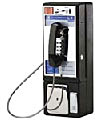Will the payphone survive? AT&T to sell off its 65,000 remaining payphones
05 December 2007
With mobile phones reducing payphone use, US payphone numbers have plummeted by more than half in the last 10 years. Will kids born in the next 10 years ever see a pay phone? Ashwin Tombat reports.
 The shrinking pay phone population in the US got a body blow on Monday 3 December, when telecom major AT&T announced that it could no longer afford to maintain its remaining herd of 65,000 payphones, and that it has decided to turn them loose.
The shrinking pay phone population in the US got a body blow on Monday 3 December, when telecom major AT&T announced that it could no longer afford to maintain its remaining herd of 65,000 payphones, and that it has decided to turn them loose.
Till 1998, the US had 2.6 million payphones, but with the growing mobile phone population reducing payphone use, payphone numbers have plummeted to just 1 million today.
If independent pay phone operators do not take over the phones that AT&T abandons, telephone services are likely decline further in needy locations like prisons and across the less affluent 13 southern and mid-south states where Southwestern Bell once provided telephone services.
But AT&T executives have expressed cautious optimism that most of the phones they let go will survive, over the phase-out period that is expected to last the next year or so. The group that represents the independent operators agrees.
The optimism comes from the fact that AT&T recently cut the number of payphones it operates by about 150,000. Logically, feel the independent operators, most of the remaining units ought to be profitable.
Long and winding road
America's first payphone appeared in 1878. Like at India's STD booths, customers made their calls, got a bill and paid the money. The first coin-operated pay phone was installed in 1890, in Hartford, Connecticut.
